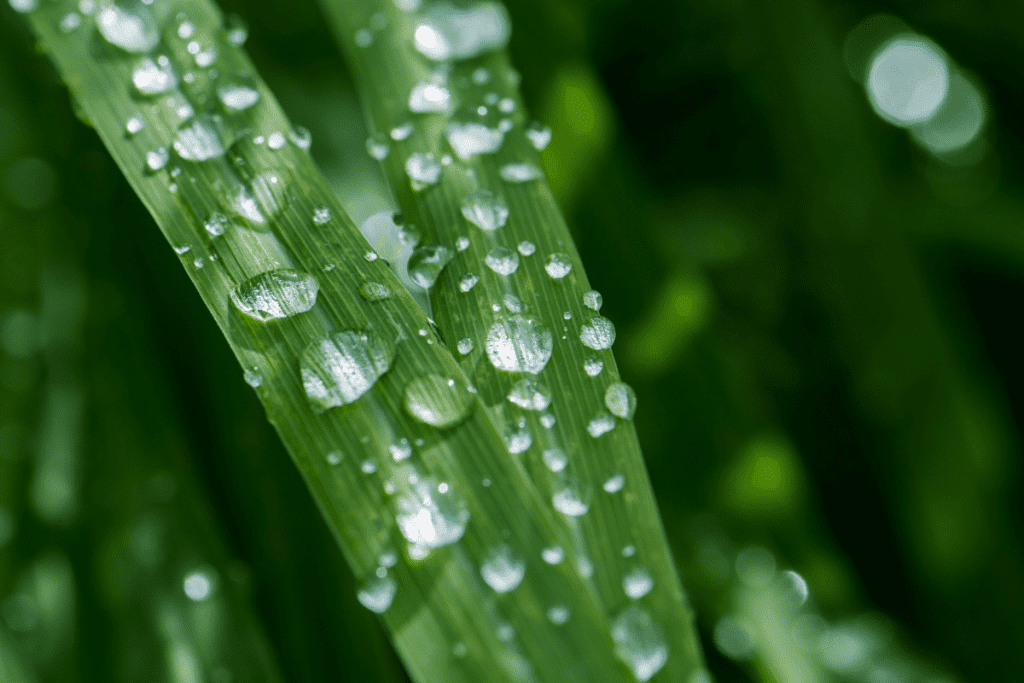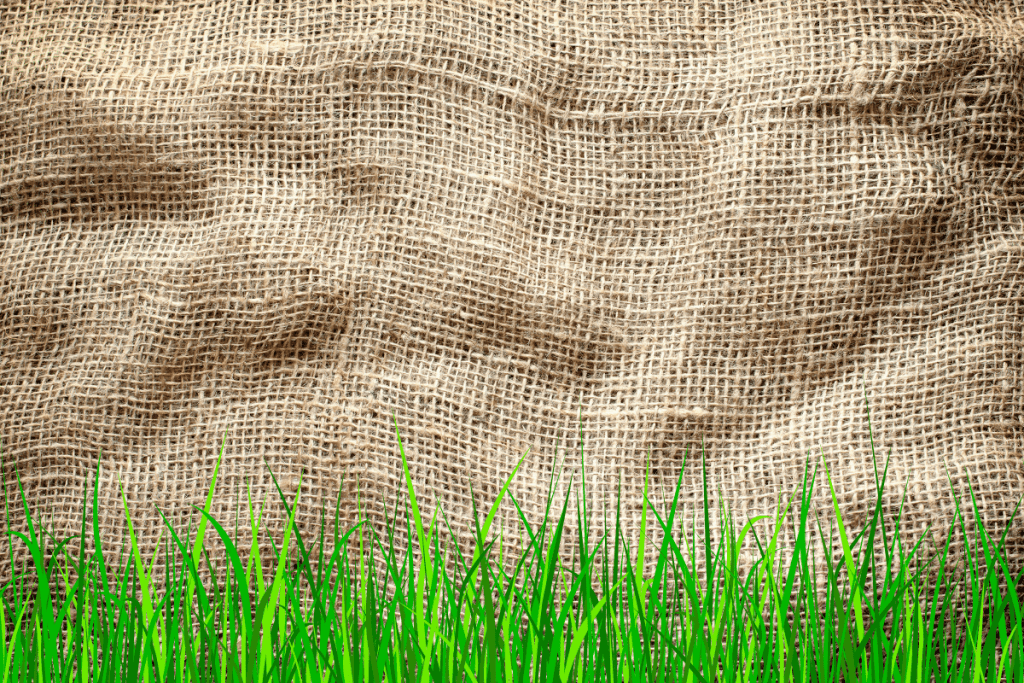Light rain is excellent for newly planted grass seed, but heavy rain will wash seeds away or cause them to float, resulting in uneven distribution giving you patchy growth.
It also shifts the soil, burying seeds and preventing germination because they are cut off from sunlight.
You don’t want to go to the trouble and expense of spreading seed to have your careful efforts ruined by an unexpected, heavy rainstorm.
Fortunately, there are multiple ways for you to protect your grass seed from heavy rainfall, and we have compiled a list of methods to check out and find what works for you.

Table of Contents
Prepare The Soil
Soil composition and compaction have a significant impact on how well your fresh grass seed withstands heavy rainfall.
If your lawn soil drains well, your seed is less likely to float, drown or wash away, so preparing the ground before you plant is highly desirable.
Aeration is recommended for compacted or dense soil which drains poorly.
Use either a spike aerator that pokes holes or a core aerator that removes small plugs of soil to loosen the ground and create better drainage.
If you have heavy clay soil, use well-draining compost mixed with loam or sandy loam to add a top layer of soil.
This will help protect your seeds from the consequences of heavy rainfall.
It’s best to sow your seeds in dry soil, making it easy to rake them gently into the top layer to ensure good seed-to-soil contact.
Raking is difficult with muddy, wet soil, and walking on it may compact it.
Compacted soil makes it harder for the seedling to develop strong roots, leading to poorer growth.
After spreading your seeds, rinse gently to moisten the seeds and top 2″ inches of soil.
Continue to water gently 2-3 times per day, just enough to keep the seeds and topsoil moist until the seeds have germinated and the seedlings are well established.
Choose An Optimal Planting Time
Choosing the optimal time to plant your seed largely depends on your variety of grass seeds.
Generally, warm-season grasses are planted in early spring, and cool-season grasses are planted in early fall.
Long-range weather forecasts are available for 14 days up to one month in advance, so check the upcoming weather conditions and choose a window to plant where no heavy storms are forecast.
If you live in areas with heavy, wet weather during spring or fall, you may decide to move your planting time to the early or late summer months depending on your grass type, the conditions forecast, and whether you live in an area prone to summer flash floods.
In areas with drier conditions, you will need to be more vigilant about keeping the seeds and top 2″ inches of soil constantly moist, but you are less likely to have your efforts ruined by heavy rain.
The germination time for your grass seeds will be anywhere from 5-30 days or longer, depending on grass type, temperature, soil conditions, and the amount of sunlight they receive.
Obviously, the longer the seed germination time, the more likely the chances of an unexpected or sudden deluge, so keeping them in place presents a challenge.
Cover with Organic Mulch
Covering with a light layer of mulch is an effective option to prevent your delicate seed from washing away during heavy storms.
It also has the added advantage of protecting the seeds from being eaten by birds.
Spread mulch such as compost, sawdust, shredded paper, or dried lawn clippings over your seeds after you first water them, just enough to protect them but not too much to prevent air, moisture, and sunlight from reaching them.
Check out how long it takes grass clippings to decompose in our article here.
Leave the organic mulch in place throughout the entire germination period to protect your seeds from any unexpected downpours.
They will gradually decompose, adding back nutrients to the soil to nourish your new grass.
Spread Peat Moss
If cost is not a barrier or seeding small patches, spreading peat moss is another excellent option to protect your vulnerable seeds.
Environmentally friendly and biodegradable, peat moss will not prevent heavy rainwater from reaching your seeds.
Still, it will prevent them from being washed away or pushed down too far into the soil for them to germinate.
Spread a light layer so the soil is still visible to allow sunlight and moisture to reach your seeds and leave them in place until all of them have sprouted.
Cover With Straw Or Hay
Covering your grass seed with a layer of straw or hay will not only protect the seeds from washing away during heavy rainfall but will also protect your topsoil from erosion.
Typically one bale of straw or hay will cover 500-1000′ square feet of seed.
The only drawback with using regular straw or hay is they contain weed seeds that will germinate along with your seed.
After your seeds germinate and the straw is removed, these will need to be weeded out.
A better option is to use wheat, oat, or barley straw available from landscaping stores.
Grain straws are unlikely to contain weed seeds, and some sources are certified to be weed seed-free.
If you use this type of straw, you will not have to worry about dealing with weeds after the seeds have germinated.
Check out our post on how long to leave hay on grass seed and what to do next for additional information.
Cover With Burlap Fabric

Burlap fabric is an excellent option for covering seed when heavy rain is expected, and similar to straw, it will also protect the soil from erosion.
The gaps in the coarse fabric will allow sunlight and moisture to reach your seed, and the covering will protect your seeds from washing away.
If you have burlap on hand as burlap bags, cut and sew together to make blankets to cover.
Otherwise, rolls of natural burlap fabric are available either online or from garden centers and home improvement stores.
Your best choice is untreated, biodegradable burlap.
Cut the fabric to size and lay it out over the seeds, ensuring the edges of the material are flush or overlapping and secure with yard stakes.
Synthetic burlap should be removed after the storm has passed, but natural, biodegradable burlap may be left in place.
The new grass will grow through the holes in the fabric, anchoring it to the soil where it will gradually decompose.
Use Erosion Control Blankets
Soil erosion blankets are made from woven synthetic or natural fibers.
They are designed to protect topsoil from washing away during heavy storms and are another excellent option for protecting grass seeds from the elements.
Natural erosion blankets made from coconut fibers, curled wood fibers, or straw are an excellent choice because they will degrade over time if left in place, adding nutrients to the soil to feed your new grass.
Suppose you use synthetic blankets, or the natural blankets will take too long to decompose and interfere with your mowing activity.
In this case, it’s safe to remove them straight after the storm has passed but once the seeds have germinated and begin to poke through, you risk uprooting them.
Lay Lawn Seed Blankets
Also known as grass seed germination blankets, these coverings contain grass seed and the nutrients needed for optimal growth of your new grass.
Using this option instead of spreading seed will prevent the embedded seeds from washing away during heavy rainfall and ensure your new grass growth is even and not clumpy or patchy.
Moreover, seed blankets reduce the chances of weeds.
Seed blankets are normally biodegradable and are designed to be left in place after the seeds have germinated.
Attempting to remove them will uproot the new grass seedlings, allowing the new grass to grow in and the blanket to decompose over time.
Cover With Landscaping Fabric
Although landscape fabric is usually laid under the soil to prevent weed growth, it’s also a good option for protecting grass seed from heavy rainfall.
This is because landscape fabric has tiny holes which will allow some water and oxygen to reach your seeds, but it won’t let in enough water to disturb them or wash them away.
Lay the fabric so water runs off rather than pools anywhere, and remove it after the rainstorm is over.
Speaking of water, make sure your seed grows well by checking out our guide for how often to water grass seed.
Protect With Cardboard
A cost-friendly method is to lay pieces of cardboard over your seeds to protect them during a storm, especially if you have cardboard boxes around the house.
Otherwise, look for free cardboard boxes discarded by grocery stores or other businesses.
Break down the boxes and lay them flat pieces of cardboard over your seeds.
Because the cardboard sheeting will prevent the seeds from receiving sunlight, it needs to be removed after the storm has passed.
Cover With Plastic or Tarps
Another option is to use light tarps or thin plastic sheeting such as 3-4 mm drop covers to overlay your seeds before any expected heavy rainfall.
For seeds that haven’t germinated, cover them with the tarp or plastic and secure them with stakes until the storm has passed.
When removing, take care to ensure any pooled water does not splash over to disturb the seeds.
If some of the seed has germinated, the use of tarps or plastic sheeting is not recommended because the weight of any pooled water will crush any new seedlings beneath it, and they won’t survive.